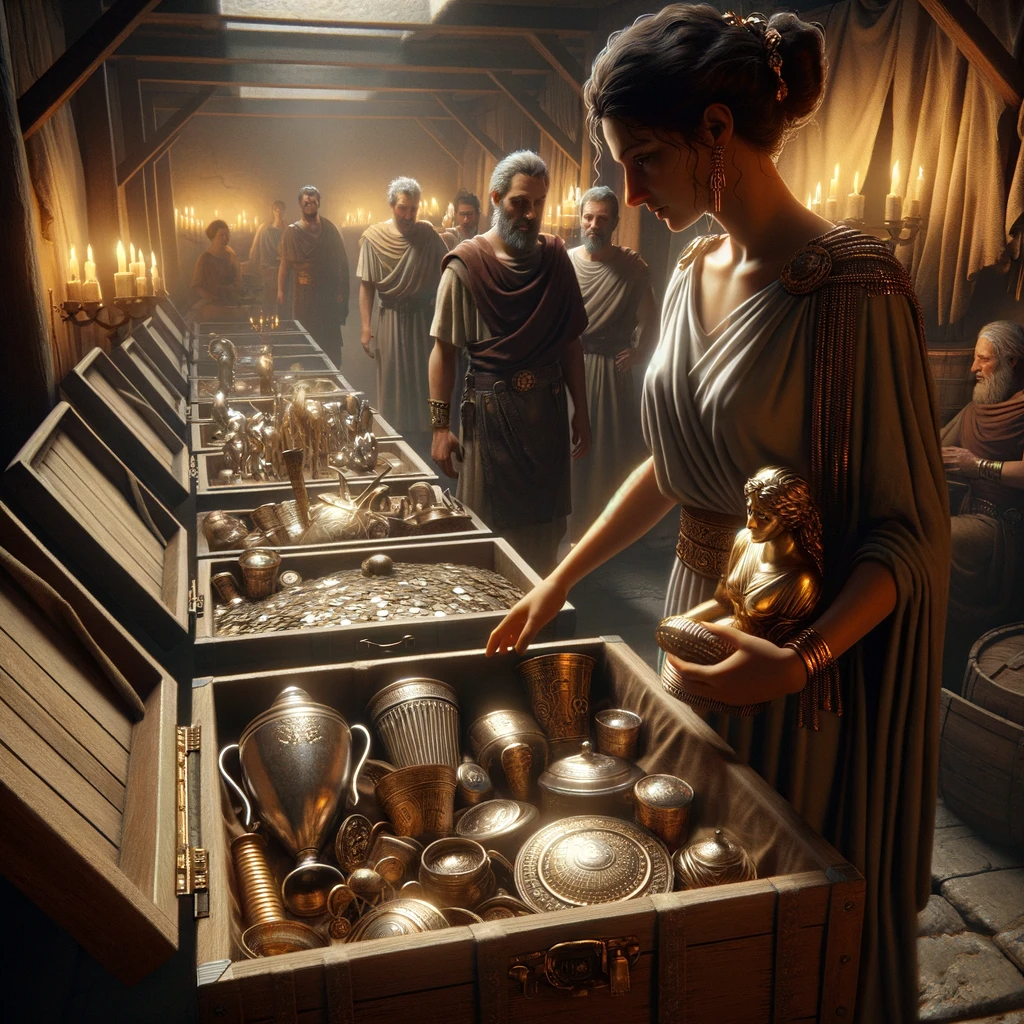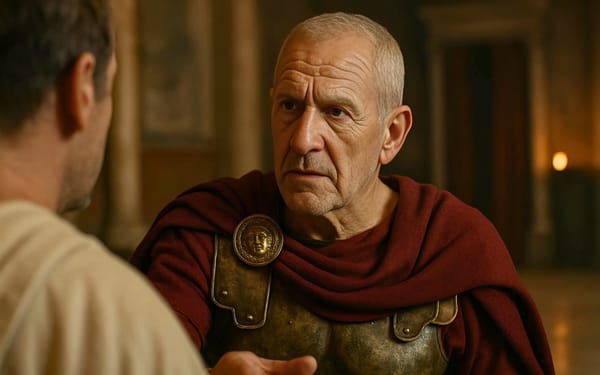The last moments of The Boscoreale Treasure
In the heart of ancient Boscoreale, Maxima, daughter of a wealthy banker, faced Vesuvius's fury to protect her family's treasure. Her story, a dramatic tale of courage and legacy, echoes through time, immortalized by the Boscoreale Treasure.

Disclaimer
This story is based on historical figures, but is ultimately a work of fiction. We're a small team of human writers, fascinated with Ancient Rome and its myriad myths and legends. Narrating fantastical stories to each other started as a hobby; and with the help of AI tools, we are able to share our passion with the rest of the world. We wholeheartedly wish you enjoy our craft – Carpe diem.
In the shadow of the looming Mount Vesuvius, in the prosperous town of Boscoreale, lived Maxima, the daughter of Lucio Cecilio Giocondo, a wealthy Pompeian banker. Maxima, known for her grace and intelligence, was the apple of her father's eye, raised amidst the luxuries that only the elite of Roman society could afford.
This grand estate that covered more than 1000 square meters was not just a home; it was a vibrant center of culture and luxury, a testament to the opulence of Roman high society.
Villa della Pisanella with its sprawling gardens and elegant architecture, was the epitome of Roman refinement. Maxima, a patron of the arts and a lover of beauty, often hosted gatherings that were the talk of the town. Poets, philosophers, and artists frequented these soirées, adding to the intellectual allure of the estate.
The heart of the villa was the atrium, a spacious, open-air courtyard surrounded by elegant columns. A marble impluvium in the center collected rainwater, creating a serene water feature that reflected the sky above. The walls around the atrium were adorned with intricate frescoes depicting scenes from Roman mythology, their vibrant colors and detailed artistry speaking of the skill of the finest painters of the age.
Adjacent to the atrium was the triclinium, or dining room, where Maxima hosted her famous banquets. This room was a testament to luxury, with plush couches arranged around a central table made of the finest wood and inlaid with ivory and gold. The walls were decorated with more frescoes, these ones showcasing bountiful feasts and Bacchanalian revelries, while the floor boasted a detailed mosaic, a masterpiece in itself.

Beyond the triclinium lay the peristyle, an enclosed garden that served as a private oasis. Here, exotic plants and flowers from across the empire bloomed in abundance, watered by an elaborate system of aqueducts. Statues of gods and goddesses stood among the greenery, their marble forms adding a divine touch to the garden. In the evenings, the peristyle was lit by oil lamps that cast a soft, golden glow, creating an enchanting atmosphere.
The bedrooms, or cubicula, were no less grand. Each room was a haven of comfort, with large, feather-stuffed beds draped in silken linens and soft woolen blankets. The furniture was made of the finest woods, ornately carved and often gilded. The walls here too bore frescoes, but these were more intimate in nature, depicting scenes of love and beauty.

No Roman villa was complete without its baths, and Maxima's villa boasted one of the most lavish. The caldarium, tepidarium, and frigidarium offered a full bathing experience, from steamy hot baths to refreshing cold plunges. The floors and walls were heated by a hypocaust system, ensuring a comfortable environment. The baths were not just a place for cleanliness but also for relaxation and socialization.
Hidden within the villa was a room that housed a Treasure. This room, known only to Maxima and her closest confidants, was where the silverware, jewelry, and coins were displayed. Each piece was a work of art, reflecting the wealth and status of the Cecilio family.

On balmy evenings, the air in the villa's verandas was filled with the sound of lyrical poetry and the clinking of wine cups. Guests would recline on luxurious couches, savoring fine wines from Maxima's collection, served in exquisite silverware that glittered under the silver moonlight. The gardens, with their tropical flowers and softly gurgling fountains, provided a perfect backdrop for tales of love and heroism, recited by the finest poets of the day.
Villa della Pisanella also played host to grand balls and banquets, where the elite of Boscoreale and Pompeii mingled under starlit skies. Musicians played enchanting melodies as couples danced in the moonlight, their laughter and joy echoing through the corridors of the villa. Maxima, always gracious and charming, ensured that every guest felt welcomed and cherished.

The gardens of the villa were a haven of tranquility and beauty. Lovers would often stroll along the pathways, their whispers blending with the rustling of leaves. The air was heavy with the scent of jasmine and roses, and the soft glow of lanterns added a touch of magic to the night. It was in these gardens that many a love story blossomed, nurtured by the beauty and serenity of the surroundings.
Amidst this world of elegance and joy, the signs of impending doom began to manifest. The day Vesuvius decided to unleash its fury started like any other, with the villa bustling with activity. But as the ground shook and the sky darkened, Maxima's world changed forever.
Dooms Day
It was mid-afternoon when the first earthquake struck. In the atrium, a servant was arranging fresh flowers when the ground shook violently. Vases, exquisitely painted and perched on pedestals, toppled and shattered, their fragments scattering across the mosaic floor like fallen stars.

In the kitchen, where preparations for the evening's feast were underway, the tremors caused a scene of havoc. A cook, startled by the sudden shaking, lost her balance and stumbled into a shelf, sending pots and pans clattering to the ground. Another servant, carrying a tray of delicacies, watched in horror as it slipped from his hands, its contents spilling across the floor.
Outside in the peristyle, the earthquake transformed the tranquil fountain into a wild, splashing torrent. Water cascaded over its marble basin, drenching the surrounding flowers and statues. The once peaceful garden was now a scene of disarray, with leaves and petals swirling in the wind.

Lucio Cecilio Giocondo, Maxima's father, rushed from his study, his heart pounding with concern. As he made his way through the villa, he called out for his family and servants, ensuring everyone was safe. The fear in his eyes was mirrored in the faces of his household, as they gathered in the atrium, seeking solace in each other's presence.
In the brief moments of calm that followed the initial quakes, Maxima took charge, her voice steady as she instructed the servants to clean up the debris and salvage what they could. But the air was thick with tension, the uneasy quiet a stark contrast to the usual harmony of the villa.
As the day turned into evening, and the ground continued to tremble, the looming threat of Vesuvius became ever more apparent. Maxima, looking at the treasured artifacts of her family, made the fateful decision to protect them from whatever was to come.
In a race against time, she orchestrated the burial of her family's treasure, a desperate attempt to safeguard the legacy of generations.
She gathered her most trusted servants, outlining a plan to bury the Boscoreale Treasure in the storeroom of the villa, a place where it might remain hidden and safe from the impending disaster.
Under Maxima's guidance, the servants began the delicate task of gathering the treasure. They moved through the villa, collecting the exquisite silverware, the intricate gold jewelry, and the precious gold coins. Each item was handled with the utmost care, a silent acknowledgment of its value and history.
The storeroom, typically used for storing wine and provisions, was quickly emptied to make space for the treasure. Located near the villa's wine-pressing room, it was a secure and discreet location, ideal for their purpose. The servants worked swiftly, clearing out barrels and crates, their movements hastened by the growing sense of urgency.
In the dim light of the storeroom, Maxima oversaw the packing of the treasure. Wooden chests, lined with soft cloth, were used to store the silverware and jewelry. Each piece was carefully wrapped to prevent damage, their beauty and craftsmanship shining even in the flickering torchlight.

The gold coins were placed in a sturdy leather bag, its weight a testament to the immense wealth it contained. Maxima herself handled the most precious items, including the silver cup depicting Cleopatra Selene and the skyphos cups of Augustus and Tiberius, placing them gently into the chests.
With the treasure securely packed, the next task was to bury it. The servants dug a deep hole in the earthen floor of the storeroom, their shovels moving rhythmically as they worked against time. Maxima watched, her heart heavy with the knowledge that she was hiding a part of her family's soul.
Once the hole was deep enough, the chests and the bag of coins were carefully lowered. The servants then covered them with earth, erasing any sign of the burial. The final act was to rearrange the storeroom, ensuring that it appeared undisturbed.
As they finished, the ground shook violently, a stark reminder that the eruption was imminent. Maxima and her servants hurried out of the storeroom, casting one last glance at the now-hidden treasure.
In the days that followed, Vesuvius unleashed its fury, burying the villa and its surroundings under layers of ash and pumice. Maxima, her family, and her servants were among the many lives lost in the tragedy.
The Boscoreale Treasure, buried in the storeroom of Maxima's villa, lay undisturbed for centuries, a silent witness to the opulence and artistry of a bygone era. Its eventual discovery would open a window into the past, revealing the story of a woman who, in her final moments, sought to protect the legacy of her family.
A short story about the Boscoreale treasure, found in the Villa della Pisanella









About the Roman Empire Times
See all the latest news for the Roman Empire, ancient Roman historical facts, anecdotes from Roman Times and stories from the Empire at romanempiretimes.com. Contact our newsroom to report an update or send your story, photos and videos. Follow RET on Google News, Flipboard and subscribe here to our daily email.
Follow the Roman Empire Times on social media: